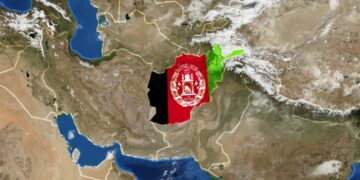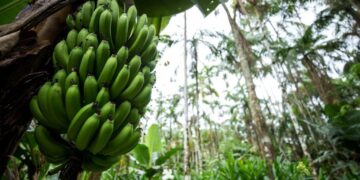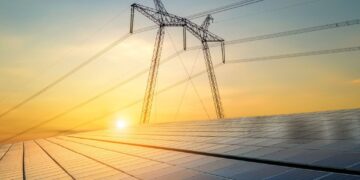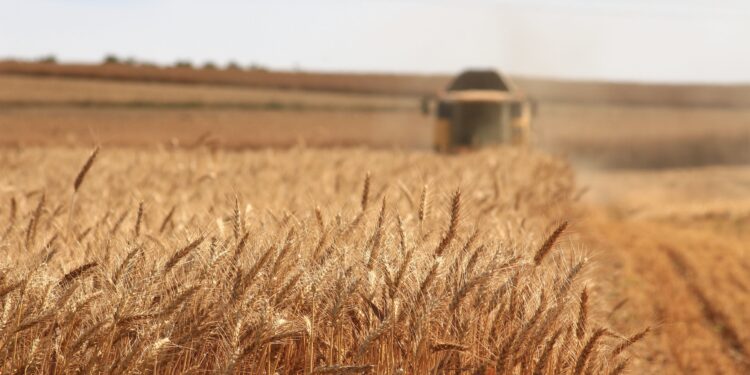Kinga Comblik;1 Mary-Jane Hawkes;2 Marie Lunel;3
1Sustainable Development and Cleaner Production Center, Boğaziçi University, Turkey, 34342
2Üsküdar American Academy, Turkey 34664
*Corresponding Author Email: abdulkadir.ahmed@boun.edu.tr …
Highlights
- The agri-food industry generates a high percentage of Carbon dioxide, Nitrous Oxide, and Methane, which are all enormous drivers of climate change
- It is estimated that 1.3 billion tons of food are wasted globally per year, which translates to 1/3rd of the total food produced, and equates to 3300 metric tons of CO2 emission.
- Under a circular economic model, food waste can be re-integrated back into the food production system or be reused to produce other value-added products
- Sustainable approaches should be adopted to reduce the dependence on chemical fertilizers
- Smart farming and smart agriculture technologies have great potential in the different aspects of agri-food systems
Graphical Abstract

Abstract
The Covid-19 pandemic not only has halted our day-to-day life but has also slowed down our progress towards attaining the Sustainable Development Goals (SDGs) by imposing constraints in our social and economic lives. Hence, an all-hands approach in which stakeholders come together to ensure the implementation of the SDGs is essential for a post-pandemic recovery. As the SDGs are perceived as an invisible whole, it is eminent that synergies and tradeoffs exist within the different goals they present. This review paper explores the environmental-human linkage within SDG 2 and SDG 12 by focusing on optimizing the synergies between sustainable food production systems and resilient agriculture practices while addressing how to reduce the tradeoffs between these goals. The paper analyzes thematic focus areas such as resource utilization in the agri-food sector, food loss and waste management, IoT (Internet of Things) technologies and smart farming, the circular economic model for the agri-food industry, and food security. Moreover, the paper investigates specific targets and indicators for both SDG 2 and SDG 12 and explores these targets within the framework of proper food waste management; increased crop yield; sustainable food production methodologies; the effect of the food production sector on the environment; as well as efficient resource use including water, land, and Nitrogen in the context of Turkey.
Keywords: Food loss and waste, Smart farming, Resilient agriculture systems, Responsible food production, Food security.
1. Introduction
The COVID-19 pandemic has shown how the different aspects of social and economic life are vulnerable to external disturbances. Although the slowing down or halting of various
economic sectors has had a negative impact and caused fragility within different sectors, it has also resulted in the overall reduction of emission and waste for specific industries (Adelodun et al., 2021) and the agri-food industry is no exception. The agri-food industry generates a high percentage of Carbon dioxide, Nitrous Oxide, and Methane, which are all enormous drivers of climate change, and the food supply chain emits an estimated amount of 13.7 billion tons of CO2eq. of GHG (Greenhouse Gas) globally (Neufeld, 2020) Hence, it’s evident that a change within the system is needed to meet GHG reduction goals. However, the pandemic has also impacted access to food and increased food insecurity (WFP, 2020; WFP, 2021). Hence, a less economically disruptive transition towards sustainable production and agriculture should be explored, and is essential for a decarbonized post-pandemic recovery. This is especially important because an additional 83-132 million people were estimated to suffer from hunger and different forms of malnutrition in 2020 (Nguyen, 2020).For Turkey, it is reported that despite the pandemic, both agriculture and agriculture-based exports increased by 4% and 6.3%, respectively, in 2020 (Anadolu Agency, 2020). However, despite the growth of agricultural yields in the country amidst a global decline, Turkey is still at risk of food insecurity, worsened by the impact of the COVID-19 pandemic on the agri-food sector globally (Urak & Bilgic, 2023). Hence, this paper explores the state of the agri-food sector in Turkey during the pandemic under an integrated framework of SDG 2 and SDG 12. Policy frameworks and actions set into place to promote and ensure a resilient and sustainable agri-food system are also discussed.
2. Methodology
This study analyzed different papers on sustainable and resilient agri-food systems. Google Scholar and Web of Science databases are used to search for peer-reviewed publications under the keywords “Agri-food industry,” “Sustainable food production,” “Food waste management,” and “Resilient agricultural systems.” Additional keywords such as “post-pandemic recovery,” “COVID-19”, “Turkey”, “Sustainable development goals”, “SDG 2”, and “SDG 12” are used to filter out the papers further. A special focus was given for papers and abstracts focusing on the environmental and social aspects of the “agri-food industry,” and papers with economic aspects of the “agri-food industry” are filtered out as that topic is prominent and broad on its own. Since this review paper focuses on the agri-food system during the pandemic era, papers that were only published during 2019-2021 were chosen. Finally, papers were filtered out based on their title and abstract and were examined. Following that, the collected information was synthesized. Additionally, data collected from the Turkish Statistical Institute and the Food and Agricultural Organization (FAO) was used to analyze and compare the change in crop yield and fertilizer usage during the pandemic and the years prior. The themes discussed in the study include food waste management in the agri-food system, biobased circular economy, efficient resource use for resilient agriculture systems, crop yield and food security, and smart agricultural technologies.
3. Results
A sustainable and resilient agri-food system is broad. It addresses a multitude of economic, social, and environmental hotspots within the frameworks of SDG 2, which focuses on ending hunger, achieving food security, improving nutrition, and promoting sustainable agriculture, as well as SDG 12, which focuses on ensuring sustainable consumption and production patterns. Within these goals are targets and indicators that are set to measure progress with food loss and waste being prominent ones as they are integrated within the whole food supply chain and intersect different targets of SDG 2 and SDG 12. This includes efficient resource use, reduction of environmental pollution from the agri-food sector, proper waste management and substantial waste reduction, crop yield and food security, as well as sustainable consumption and food production methodologies. As a result, food loss and waste are heavily discussed regarding post-covid recovery (Galanakis, 2020; Ceylan & Özkan, 2020). According to a report by the Food and agriculture organization, approximately 1.3 billion tons of food are wasted globally per year which translates to 1/3rd of the total food produced and equates to 3300 metric tons of CO2 emission (Galanakis, 2020). In the case of Turkey, avoidable food waste throughout the food supply chain was estimated to be 16 metric tons annually. Additionally, food waste is interrelated with GHG emission and resource efficiency and, as a result, it is interconnected to Indicator 6 (Phosphorus use efficiency), Indicator 15 (Nitrogen use efficiency), and Indicator 16 (Crop water productivity) of SDG 2. This entails that food waste has a carbon, energy, and water footprint which is estimated to be 23.7 Mt CO2-eq/y, 13.5 ×10⁴ TJ/y, and 6.2 × 109 m³/y respectively for Turkey (Cakar et al., 2020). From the economic perspective, The Federation of Food & Drink Industry Associations of Turkey estimates an economic loss of $39 bn due to food waste (Cakar et al., 2020). Similarly, the economic and environmental impact of food waste makes up 15% of the entire food chain globally (Galanakis, 2020). Hence, proper food waste management is a viable alternative to reduce the emission of GHG and decarbonize the agri-food industry without further exacerbating the fragility in the sector caused by the COVID-19 pandemic (Adelodun et al., 2021; Ceylan & Özkan, 2020).
It is also interesting to note that, food waste is reduced during the pandemic era due to improved consumer habits such as purchasing highly conservable or easily preservable food, buying and cooking fresh food, and avoiding processed food due to health reasons. Moreover, consumers have shown a preference for organic food, further pushing for organic agricultural practices. (Güney & Sangün, 2021; Özbük et al., 2022; Toktaş, 2020).
Food waste and loss are also heavily intertwined with annual crop yield. This has been the case during the COVID-19 pandemic, in which a spike in food and crop waste was observed during seasonal crop harvesting because of the lockdown measures installed (Ceylan & Özkan, 2020). However, in the case of Turkey, policy measures have been taken, and programs such as “The development of plant production program” has been implemented during the pandemic to utilize abandoned agricultural lands fully (Uysal & Veziroğlu, 2020). Additionally, Turkey has also established long-term strategic plans such as the 2019-23 Strategic Plan of the Ministry of Agriculture and Forestry (MoAF), which has seven strategic objectives, including food production (OECD, 2021), Turkey’s National Strategy Document and Action Plan, which mainly focuses on prevention of food loss and waste management, and “The Extension and Control of Organic Agriculture Project”, which is aimed at increasing the organic agricultural production (Ministry of Environment and Urbanization, 2020). However, the studies analyzed didn’t address the effects of these programs and policy frameworks on the annual crop yield of Turkey in the pandemic era. Hence, data was taken from the Turkish statistical institute and analyzed to understand the change in crop yield in 5-year period between 2016 – 2020. Data on 77 types of agricultural crop products, including wheat, barley, sorghum, peanut, corn, cotton etc. was collected, and the total value is presented in Table 1.

Table 1: Annual crop yield of Turkey for 77 different types of farm foods between 2016-2017. Table adapted from the Turkish Statistical Institute (Turkstat, 2021).
As can be seen in the table and the figure below, there has been a substantial increase in the crop yield of 2020, albeit the pandemic, and the why and how is not addressed in the studies.

Figure 1: Annual crop yield of Turkey in Kilogram/Decare. Figure adapted from the Turkish Statistical Institute (Turkstat, 2021).
Adaptation of the circular economic model in place of a linear economic model is also an approach that is suggested in studies for attaining a sustainable agri-food system as well as waste valorization. Under a circular economic model, food waste can be re-integrated back into the food production system or be reused to produce other value-added products (Debnath & Sarkar et al., 2023). This includes the utilization of bioactive such as dietary fiber, phenols, flavonoids, essential oils, sugars, carotenoids, ascorbic acids, etc. from agri-food wastes such as citrus waste to produce preservatives, gelling agents, and nutritional supplements (Adelodun et al., 2021; Ben-Othman, 2020; Giudice, 2020) Additionally, the recapturing and reusing of bio-active products can decrease the environmental impacts of the food supply chain and can be implemented alongside other sustainable practices in the production of food, such as the utilization of non-thermal technologies in food processing for a more integrated approach (Galanakis, 2020). Moreover, a life cycle assessment approach throughout the supply chain can identify environmental hotspots which then can be integrated within the circular economic model. Additionally, a life cycle assessment software such as FoodCarbonScope has been used in studies to understand hotspots further and optimize results in the context of Turkey (Cakar et.al, 2020).
A circular economy can also be assessed from the perspective of soil restoration and soil quality management which entails on-farm cycling of nutrients via the utilization of bio-slurry and compost from agricultural and food waste (Lal et al., 2020). This is of particular importance when looking into the data regarding global fertilizer use in the past years and the pandemic area as can be seen in Table 2 and Figure 2. Moreover, according to data provided by the International Fertilizer Association (IFA), the global fertilizer use for 2019-2020 has spiked up to 190 million tons, and the COVID-19 pandemic is estimated to have little to no impact on global fertilizer production and fertilizer companies (Ilinova et al., 2021).

Table 2: Global Fertilizer Use, 2016-2021. Table adapted from the FAO Statistical Databases & Data-Sets (FAOSTAT, 2021).

Figure 2: World demand for nitrogen, phosphorus and potassium for fertilizer use, 2016-2022 (thousand tons). Figure adapted from the FAO Statistical Databases & Data-Sets (FAOSTAT, 2021).
This is also the case for Turkey, which has seen an overall increase in the usage of chemical fertilizer and, most specifically, the use of Nitrogen (21% N) and Phosphorous (17% P2O5) as can be seen below.

Table 3. Chemical fertilizer use, 2015-2020 (Tons). Table adapted from the Turkish Statistical Institute (Turkstat, 2021)

Figure 3. Chemical fertilizer use, 2015-2020 (Tons). Figure adapted from the Turkish Statistical Institute (Turkstat, 2021).
Looking at the available data, it is evident that sustainable approaches should be adopted to reduce the dependence on chemical fertilizers. Apart from the aforementioned on-farm cycling of nutrients for the production of compost and organic fertilizers, studies also suggest that a transition from traditional or industrial agriculture to an agroecological system can introduce small-scale and family farming practices that can increase soil health and create a more resilient and sustainable agri-food system by reducing unsustainable land usage (Altieri & Nicholls, 2020).
An agroecological system can also be adapted in urban areas and it can play a crucial role in creating local food security and reducing instability due to external shocks and their effects such as the panic buying and food stockpiling that has been witnessed on the onsets of the pandemic both by individual consumers and government bodies (Altieri & Nicholls, 2020; Lioutas & Charatsari, 2021). This has caused a demand shock which results in a temporary spike in the global food shortage (Lioutas & Charatsari, 2021). This reflects the unsustainable consumption habits of the pandemic era. Food security is also mainly assessed through the global food security index, which has shown fluctuation for different countries during this pandemic. In the case of Turkey, the country’s global food security index has dropped by 2.3% in 2020 from the overall score of 63.5 in 2019 to 61.2 in 2020 (The Economist, 2021). However, the global food security index for 2021 showed a rise of 3.9% with an overall score of 65.1%, making Turkey the country with the second-highest percentage increase right after Malaysia (The Economist, 2021). While looking into the separate categories, and more specifically natural resources and resilience, although Turkey is ranked 27th in the category with great overall scores, there is a huge percentage decrease in the water efficiency (The Economist, 2021). This is especially concerning as the water demand for agricultural production is expected to increase by 60% by 2025 (Boretti & Rosa, 2019). Hence, the focus should be given to efficient water usage in agri-food systems. Finally, the pandemic has also shown us the need for digitization and conducting work remotely in all sectors. Hence, smart farming and smart agriculture technologies are considered to have great potential in the different aspects of agri-food systems, in which Internet of Things (IoT) technologies are integrated with conventional and traditional agricultural practices for optimum results. For example, UAV (Unmanned Aerial Vehicle) technologies or drone technologies can be utilized to surveil crop yield. Moreover, remote sensing, precision agriculture, vertical farming can all be utilized to increase crop yield, implement proper resource management, and reduce food waste and loss. Sensors can also be used to understand the climate conditions of the farms and determine proper irrigation techniques in the farm, which plays a role in adapting efficient water use (Kirkaya, 2020; Telagam et al., 2021). Additionally, crop yield data from farmers’ machinery can be utilized and integrated into developing a yield stability map to understand the land productivity of a certain area better (Basso & Antle, 2020). While assessing smart farming in Turkey’s context, it can be noted that policy frameworks such as “The Communiqué on Supporting Agriculture-Based Economic Investments in Scope of Rural Development Supports” set by the Turkish government and “Internet of Food and Farm 2020” under the European Commission play major roles in popularizing agricultural technologies and accelerating the adaptation of IoT technologies in farming. (Telagam et al., 2021; Doğan & Aytekin, 2021). However, the negative aspects of smart farming and the utilization of IoT technologies in the farming community should also be considered. Autonomous systems such as spraying drones and UAVs, driverless tractors, etc. will reduce the need for human labor on farms which has an impact on the socio-economic lives of farmers and the farming communities (Lioutas & Charatsari, 2021). Hence, capacity-building programs for farmers on the utilization of smart technologies and skill training in other sectors to ensure that transition towards smart technologies will not create economic vulnerability within the farming community can be an alternative that can be looked into, which is not discussed in the literature reviewed. Moreover, discussion on the integration of smart farming technologies within rural farming communities in developing countries where access to digital infrastructure is already weak was not present in the papers reviewed, which is a major gap that should be addressed if we want to attain our SDGs without leaving no one behind.
5. Conclusion
Disruption in the food value chain due to the COVID-19 pandemic has made the agri-food sector fragile. During the pandemic era, the agri-food sector has encountered economic shocks, and already existing environmental challenges within the industry such as food loss and waste have been further exacerbated. On the other hand, the halting of activities due to COVID-19 prevention measures has led to the decarbonization and emission reduction of several industries, including the agri-food sector. In the context of Turkey, policy measures that are put into place have helped to increase crop yield and food security. However, there still exists a missing perspective regarding the overall environmental impact of the agri-food industry and how the discussed policy frameworks were put into practice during the pandemic era to see successful results. Focus has also been given to a shift from chemical fertilizers to organic fertilizers through the adaptation of a biobased circular economy and an agroecological system for better resources management and land utilization. High importance is also given to the utilization of smart farming technologies as well as adaptation of circular economic models as they both play a part in optimizing synergies between the agri-food industry and the environment. However, there exists a socioeconomic dilemma when it comes to the adaptation of smart techniques, and there is still room for discussion and research work on inclusivity in smart farming.
Author(s) Summary
Competing Interest
The authors declare that they have no competing interests.
References
Adelodun, B., Kareem, Y., Kumar, P., Kumar, V., Choi, K., Yadav, K., & Khan, A. (2021). Understanding the Impacts of the COVID-19 Pandemic on Sustainable Agri-Food System and Agroecosystem Decarbonization Nexus: A Review. Journal of Cleaner Production, 318. [Google Scholar] [CrossRef]
Altieri, M. & Nicholls, C. (2020). Agroecology and the Reconstruction of a Post-COVID-19 Agriculture. The Journal of Peasant Studies, 47(5), 881-898. [Google Scholar] [CrossRef]
Anadolu Agency (2020 November 25).Turkey’s Agricultural Exports Rise despite Pandemic. Hürriyet Daily News. Retrieved on September 25, 2022. [Website]
Basso, B. & Antle, J. (2020). Digital Agriculture to Design Sustainable Agricultural Systems. Nature Sustainability, 3(4), 254-256. [Google Scholar] [CrossRef]
Ben-Othman, S., Jõudu, I. & Bhat, R. (2020). Bioactives from Agri-Food Wastes: Present Insights and Future Challenges. Molecules, 25(3), 510. [Google Scholar] [CrossRef]
Boretti, A. & Rosa, L. (2019). Reassessing the Projections of the World Water Development Report. NPJ Clean Water, 2(1), 1-6. [Google Scholar] [CrossRef]
Cakar, B., Aydin, S., Varank, G. & Ozcan, H. (2020). Assessment of Environmental Impact of Food waste in Turkey. Journal of Cleaner Production, 244. [Google Scholar] [CrossRef]
Ceylan, F., & Özkan, B. (2020). Assessing Impacts of COVID-19 on Agricultural Production and Food Systems in the World and in Turkey. Gaziantep University Journal of Social Sciences (COVID-19 Special Issue), 472-485. [Google Scholar] [CrossRef]
Debnath, A. & Sarkar, B. (2023). Effect of Circular Economy for Waste Nullification under a Sustainable Supply Chain Management. Journal of Cleaner Production, 385. [Google Scholar] [CrossRef]
Doğan, D., & Aytekin, A. (2021). Modernisation Technologies in Agriculture and Legal Approaches to these Technologies. Mondaq. [Website]
FAOSTAT. (2021). Fertilizers by Product, Federal Agriculture Organization of the United National. [Website]
Galanakis, C. (2020). The Food Systems in the Era of the Coronavirus (COVID-19) Pandemic Crisis. Foods, 9(4), 523. [Google Scholar] [CrossRef]
Giudice, F., Caferra, R. & Morone, P. (2020). COVID-19, the Food System and the Circular Economy: Challenges and Opportunities. Sustainability, 12(19). 7939. [Google Scholar] [CrossRef]
Güney, O. I., & Sangün, L. (2021). How COVID-19 Affects Individuals’ Food Consumption Behaviour: A Consumer Survey on Attitudes and Habits in Turkey. British Food Journal, 123(7). [Google Scholar] [CrossRef]
Ilinova, A., Dmitrieva, D. & Kraslawski, A. (2021). Influence of COVID-19 Pandemic on Fertilizer Companies: The Role of Competitive Advantages. Resources Policy, 71, 102019. [Google Scholar] [CrossRef]
Kirkaya, A. (2020). Smart Farming-Precision Agriculture Technologies and Practices. Journal of Scientific Perspectives, 4(2), 123-136. [Google Scholar] [CrossRef]
Lal, R., Brevik, E., Dawson, L., Field, D., Glaser, B., Hartemink, A. & Sánchez, R. (2020). Managing Soils for Recovering from the COVID-19 Pandemic. Soil Systems, 4(3), 46 [Google Scholar] [CrossRef]
Lioutas, E. & Charatsari, C. (2021). Enhancing the Ability of Agriculture to Cope with Major Crises or Disasters: What the Experience of COVID-19 Teaches Us. Agricultural Systems, 187. [Google Scholar] [CrossRef]
Ministry of Environment and Urbanization. (2020). 6th State of the Environment Report of Turkey. [Website]
Neufeld, D. (2020). The Carbon Footprint of the Food Supply Chain. Visual Capitalist. [Website]
Nguyen, K. (2020). 2020 State of Food Security and Nutrition in the World report: Rising Hunger and COVID-19 Present Formidable Challenges. International Food Policy Review Institute. [Website]
OECD. (2021). OECD Library – Turkey. [Website]
Telagam, N., Kandasamy, N. & Arun Kumar, M. (2021). Review on Smart Farming and Smart Agriculture for Society: Post-pandemic Era. In Green Technological Innovation for Sustainable Smart Societies. Springer, Cham, pp. 233-256 [Google Scholar] [CrossRef]
The Economist. (2021). Global Food Security Index (GFSI). [Website]
Toktaş, Y. (2020). Current Researches in Economics and Administrative Sciences. Montenegro: IVPE Cetinje.
Turkstat. (2021). Fertilizers. Turkish Statistical Institute Database. [Website]
Urak, F. & Bilgic, A. (2023). Food Insecurity and Sovereignty Threat to Uncontrolled Price Spillover Effects in Financialized Agricultural Products: The Red Meat Case in Turkey. Borsa Istanbul Review. [Google Scholar] [CrossRef]
Uysal, O., & Veziroğlu, P. (2020). Overview of Turkish Agriculture and Future Prospects in the COVID-19 Pandemic. Turkish Journal of Agriculture-Food Science and Technology, 8(12), 2643-2650. [Google Scholar] [CrossRef]
Özbük, R. M. Y., Coşkun, A., & Filimonau, V. (2022). The impact of COVID-19 on Food Management in Households of an Emerging Economy. Socio-Economic Planning Sciences, 82, 101094. [Google Scholar] [CrossRef]
WFP. (2020). COVID-19 Will Double Number of People Facing Food Crises Unless Swift Action is Taken. [Website]
WFP. (2021). Acute Hunger Set to Soar in Over 20 Countries, Warn FAO and WFP. [Website]
About this Article
Cite this Article
APA
Ahmed I. A & Defne D.(2023). Accelerating Sustainable Agri-Food Production and Processing in Post-Covid Recovery within Turkey’s Context. SustainE. 1(1), 82-94. https://doi.org/10.55366/suse.v1i1.6
Chicago
Iman Abdulkadir A. and Defne Ciliz. “Accelerating Sustainable Agri-Food Production and Processing in Post-Covid Recovery within Turkey’s Context.” SustainE 1, no. 1 (May 1, 2023): 82–94. https://doi.org/10.55366/suse.v1i1.6
Received
11 January 2022
Accepted
20 March 2022
Published
1 May 2023
Corresponding Author Email: abdulkadir.ahmed@boun.edu.tr
Disclaimer: The opinions and statements expressed in this article are the authors’ sole responsibility and do not necessarily reflect the viewpoints of their affiliated organizations, the publisher, the hosted journal, the editors, or the reviewers. Furthermore, any product evaluated in this article or claims made by its manufacturer are not guaranteed or endorsed by the publisher.
Distributed under Creative Commons CC-BY 4.0
Share this article
Use the buttons below to share the article on desired platforms.













